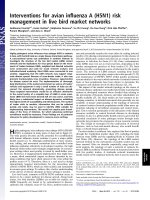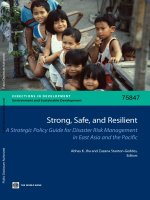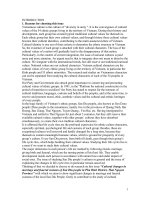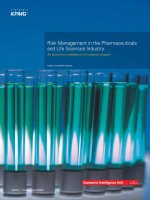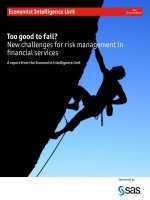Credit risk management in agribank thai nguyen province, vietnam
Bạn đang xem bản rút gọn của tài liệu. Xem và tải ngay bản đầy đủ của tài liệu tại đây (472.41 KB, 103 trang )
CREDIT RISK MANAGEMENT IN AGRIBANK THAI NGUYEN
PROVINCE, VIETNAM
___________________________
A DISSERTATION
Presented to the Faculty of the Graduate School
Southern Luzon State University, Lucban, Quezon, Philippines
in Collaboration with
Thai Nguyen University, Socialist Republic of Vietnam
___________________________
In Partial Fulfillment
of the Requirements for the Degree
Doctor of Business Administration
___________________________
By
BUI VAN KHOA (Billy)
December 2013
i
APPROVAL SHEET
The Dissertation of
ii
CERTIFICATE OF ORIGINALITY
iii
ACKNOWLEDGMENT
The researcher wishes to convey his gratitude to the following persons
who wholeheartedly devoted and helped make this piece of work a reality:
DR. WALBERTO A. MACARAAN, for his invaluable support and supervision
throughout my graduate study program; likewise, for his indefatigable
effort in providing daily instructions during the duration of the study,
thus, this dissertation is as much his work as mine;
DR. CECILIA N. GASCON, President of the Southern Luzon State University
in the Republic of the Philippines, for initiating the joint offering of the
Doctor of Business Administration with TNU, through the ITC-TUAF;
DR. DANG KIM VUI, President of Thai Nguyen University, for his approval of
the international collaboration with Southern Luzon State University,
Republic of the Philippines and for the joint offering of the Doctor of
Business Administration, through the ITC-TUAF;
DR. TRAN THANH VAN, dean of Graduate School of Thai Nguyen University,
for his assistance and encouragement to pursue this study;
DR. DANG XUAN BINH, director of International Training Center, and DR.
NGUYEN THANH HAI, vice director of International Training Center,
for their assistance and encouragement to pursue DBA;
DR. CONRADO L. ABRAHAM, DR. JOANNA PAULA A. ELLAGA, DR.
EDWIN P. BERNAL, and DR. ALICE T. VALERIO, panelists, for their
support and constructive criticisms to improve this dissertation;
iv
SLSU and TNU Professors, for support and guidance extended throughout
the graduate studies in Thai Nguyen University, Vietnam;
Family and friends, for the love and support in one way or another; and to all
who have contributed to make this study a success.
BVK
v
DEDICATION
This piece of work
is dedicated to
my wife and my boy,
all the staff of the Agribank in Thai Nguyen Province.
BVK
vi
TABLE OF CONTENTS
PAGE
TITLE PAGE ………………………………………………………………..
i
APPROVAL SHEET ……………………………………………………….
ii
CERTIFICATE OF ORIGINALITY ………………………………………..
iii
ACKNOWLEDGEMENT …………………………………………………..
iv
DEDICATION ………………………………………………………………
vi
TABLE OF CONTENTS …………………………………………………..
vii
LIST OF TABLES ………………………………………………………….
ix
LIST OF FIGURES ………………………………………………………...
xi
LIST OF APPENDICES …………………………………………………...
xii
ABSTRACT …………………………………………………………………
xiii
CHAPTER
I
II
III
INTRODUCTION ……………………………………………
1
Background of the Study …………………………………..
2
Objectives of the Study …………………………………….
4
Hypothesis of the Study ……………………………………
5
Significance of the Study …………………………………..
5
Scope and Limitations of the Study ………………………
6
Definition of Terms ………………………………………….
7
REVIEW OF LITERATURE ……………………………….
11
Conceptual Framework ………………………………….…
37
Research Paradigm ………………………………………...
38
METHODOLOGY …………………………………………..
40
Research Design ……………………………………………
40
Population and Sampling …………….…………………….
40
Instrumentation …….……………………………………….
42
Data Gathering Procedure …………………………………
42
Statistical Treatment ………………………........…….……
43
vii
IV
V
RESULTS AND DISCUSSIONS ………………………….
45
Profile of the Respondents …………………...……………
45
Assessment of Agribank Thai Nguyen Credit Risk ……..
46
Assessment of the Current Status of Debts of Agribank
Thai Nguyen …………………………………………………
52
Factors Affecting Credit Risks Management of Agribank
Thai Nguyen …………………………………………………
62
Significant Difference in the Assessment of Two Groups
of Respondents on Credit Risk Management …………...
65
Recommendations on Credit Risk Management of
Agribank Thai Nguyen to Minimize Credit Risk ………….
70
SUMMARY OF FINDINGS, CONCLUSIONS AND
RECOMMENDATIONS
Summary …………………………………………………….
72
Findings ……………………………………………………...
73
Conclusions …………………………………………………
76
Recommendations …………………………………………
76
REFERENCES ………………………...…………………………………..
78
APPENDICES ……………………………………………………………...
81
CURRICULUM VITAE …………………………………………………….
89
viii
LIST OF TABLES
TABLE
PAGE
1
Frequency Distribution of the Respondents of the Study ….
41
1.1
Frequency and Percentage of Respondent’s Profile …….…
45
2.1
Credit Risk of Agribank Thai Nguyen in terms of Segment
Structure …………………………………………………….…..
47
Credit Risk of Agribank Thai Nguyen in terms of Types of
Customers ……………………………………………………….
48
Credit Risk of Agribank Thai Nguyen as to Availability of
Guarantee ……………………………………………………….
50
Credit Risk of Agribank Thai Nguyen in terms of
Outstanding Account …………………………………………..
51
3.1
Current Status of Overdue Debt of Agribank Thai Nguyen ..
52
3.2
Current Status of Undue Debt of Agribank Thai Nguyen…...
54
3.3
Current Status of Debt Requiring Attention of Agribank Thai
Nguyen …………………………………………………………..
55
Current Status of Under Qualified Debt of Agribank Thai
Nguyen …………………………………………………………..
57
3.5
Current Status of Doubtful Debt of Agribank Thai Nguyen ..
58
3.6
Current Status of Frozen Debt of Agribank Thai Nguyen…..
59
3.7
Current Status of Bad Debt of Agribank Thai Nguyen ……..
60
4.1
Assessment of Factors Affecting Credit Risk Management
of Agribank Thai Nguyen in terms of Subjective Criteria …..
62
Assessment of Factors Affecting Credit Risk Management
of Agribank Thai Nguyen in terms of Objective Criteria ……
63
Significant Differences on Two Groups of Respondents’
Assessment of the Credit Risks in Agribank Thai Nguyen ...
65
Significant Differences on Two Groups of Respondents’
Assessment of the Current Status of Debts in Agribank
Thai Nguyen …………………………………………………….
67
2.2
2.3
2.4
3.4
4.2
5.1
5.2
ix
TABLE
5.3
PAGE
Significant Differences on Two Groups of the Respondents’
Assessment of Factors Affecting Credit Risk Management
in Agribank Thai Nguyen ………………………………………
x
68
LIST OF FIGURE
FIGURE
1
PAGE
Input-Process-Output (IPO) Model on Credit Risk
Management in Agribank Thai Nguyen, Vietnam ……………
xi
38
LIST OF APPENDICES
APPENDIX
PAGE
A
Communications ……………………………………………..
82
B
Questionnaire ………………………………………………...
84
C
Profile Of Agribank Thai Nguyen …………………………..
87
`
xii
ABSTRACT
Title of Research
: CREDIT RISK MANAGEMENT IN AGRIBANK
THAI NGUYEN PROVINCE, VIETNAM
Researcher
: BUI VAN KHOA (BILLY)
Degree Conferred
: DOCTOR OF BUSINESS ADMINISTRATION
Name and Address
of Institution
: Southern Luzon State University Lucban, Quezon,
Philippines and Thai Nguyen University, Socialist
Republic of Vietnam
Adviser
: Dr. Walberto A. Macaraan
Year Written
: 2013
______________________________________________________________
This study sought to investigate credit risk management in banks for
Agriculture and Rural Development in Thai Nguyen province with an endview
of proposing recommendations to improve the Agribank Thai Nguyen’s credit
risk management. In particular, it aimed to describe the profile of respondents
with respect to the age, gender, civil status, education, and number of years in
service; assess credit risk in Thai Nguyen Agribank, considering assessment
of the managers and staff in terms of segment structure, types of customers,
types of guarantee, and account outstanding; assess the current status of
debts of Agribank Thai Nguyen as perceived by the managers and staff as to
overdue, undue, debt requiring attention, under qualified, doubtful, frozen, and
bad debts; identifying factors affecting credit risk management of Agribank
Thai Nguyen as assessed by the managers and the staff as to subjective and
objective criteria; find out the significant difference in the assessment of two
groups of respondents on credit risk management and the factors affecting
limitations of the credit risks management of the bank. With the use of the
mixed method of research employing quantitative and qualitative analyses,
xiii
203 comprising of 40 managers and 163 staff are subjected as respondents.
The five (5)-point Likert scale questionnaire was also used for the variables
being investigated in this study. Thus, it was revealed that majority of the bank
customers are women who have marital obligations, are relatively young,
have graduated college and work for only few years in their respective jobs.
The credit risks in Thai Nguyen Agribank are assessed by the managers and
staff as to segment structure with 3.5 or more risky; types of customers with
3.4 (more risky); availability of guarantee which are just risky; and outstanding
account which is generally rated as risky with 3.40. The biggest risk for bad
debts is the difficulty to collect both the interest and capital, overdue and
undue debts is that both principle and interest is hardly recovered fully, debt
requiring attention is the absence of clear mechanism, qualified debt is the
interest that is never made free for customers, doubtful credit is less careful
appraisal of the borrowers, and frozen debt is that a lot of customers classified
in frozen debt group. The risk under subjective criteria is that bad information
quality in banking network and outside while for objective criteria is economic
environment facilities for both bank and customers. It was recommended that
the bank may require guarantee properties for credits, carefully manage the
segment structure, define exactly targeted customers, pay attention more on
long-term and medium credits and review the procedure and conditions to
manage, control and minimize risks of credit.
xiv
Chapter I
INTRODUCTION
The banking system as the lifeblood of the country plays a very important
role in the economy. Vietnam's banking system in recent years has gained
encouraging achievements which contribute to stability and control inflation, and
for the effective implementation of national monetary policies. However, in the
market economy, business risk is unavoidable, especially in the field of banking
because it has the potential to cause a chain reaction, spreading increasingly into
complicated situation.
Nowadays, bank becomes the largest payment intermediaries present in
most countries. Tran Van Viet (2004) observed that with the development of the
economy, where banks from supplying deposit has increased, the services on
many operating valuated segments such as fund mobilization, credits, payment
intermediates and others activates. However, the risks always come along with
the credit of the banks. In its efforts to gain the interest, banks cannot avoid
risks but only can find ways to make this activity become safer and to minimize
the lost by establishing a suitable strategy.
Banks always deal with competition and many different types of risks. In
Vietnam, the starting point of the banks, which is quite low compared with the
average in the region prioritize development of accurate and interest earnings.
This leads to the risk management of banks which virtually Vietnam is still at the
initial stage and the construction has not been considered satisfactory and
professional. That is why, the ratio of the bad debt problems is rising from loss
of control and is becoming an unsolved problem in most of Vietnam's current
2
banking particularly in Bank for Agriculture and Rural Development in Vietnam,
a financial institution operating mainly in the agricultural sector and rural areas
which reveals that profit is brought mainly from bank credit activity (accounting
for 90% of total banking income).
Apparently, credit risk, a possibility that the borrowers or partners cannot
carry out their responsibilities as committed, is constantly happening in every
banking system. Thus, credit risk management is crucial for the survival and the
development of the bank relative to agricultural and rural development in Vietnam.
Background of the Study
Agribank in Thai Nguyen province was formed in October 1998 on the
basis of getting the entire facility and workers from several departments of the
provincial state banks and its branches in provinces/ districts of Thai Nguyen.
These state banks and its branches started with the workforce of 760 people,
2.3 billion funding, and debt balances of 3.5 billion mainly being overdue.
Commercial banks are the industry with presently at high risk, especially
in the context of global financial crisis and adversely affect the bank's activities
in general and in particular the credit activities. In fact, on the average between
2005 and 2009, the percentage of REO commercial banks in Vietnam steadily
increased from 12% to 30%. But from early 2010 up to this day, this index has
decreased dramatically to 40% compared to that in 2009. Meanwhile in 2011, it
decreased to 30% compared to that in 2010. Net interest margins are also in a
similar situation. Profitability decreased while the CAR is very low, meaning that
the commercial banks in the recent years has paid a high price which means
that it did not perform well due to the credit risk management which is the most
evident ratio of bad debts rise.
3
The Bank of Agriculture and Rural Development of Vietnam (Agribank) is
one of the first commercial banks in Vietnam, and is considered prestigious and
has affirmed its brand domestically and internationally, not even outside general
trend of development of Vietnam's banking system since our country’s transition
to the market economy. Agribank continued its expansion of asset size, capital
size, in which the credit scale is constantly expanding and this is also the main
source of profit for the operation of Agribank.
The credit rate on the total assets of Agribank is about 80% while credit
risk management is still inadequate, the percentage of total outstanding loan is
high from 0.98% in 2005 to 2.24% in 2009, 3.3% in 2010, 6.8% in 2011 and is
expected to increase further in 2012. ROE from 2006 has tended to decrease
significantly (down to 43%). With Agribank Thai Nguyen, the percentage of total
debts balance were as follows: 1.26% (in 2006), 2.58% (2007), 2.34% (2008),
1.42% (2009), 0.98% (2010), and 0.58% (2011). Despite the bad debt ratio of
Agribank Thai Nguyen, it is also lower than that of Agribank Vietnam’s average
bad debt ratio but also the amount of bad debt increases in current economic
conditions. If the bank does not implement well in controlling risk, the efficiency
of credit activity will decrease, hence, the growth of bank becomes slow.
In this situation, while credit remains the main activities of commercial
banks, the activities of credit risk management is vital to the commercial banks
as well as Agribank Vietnam and Thai Nguyen Agribank in particular and also
the means that the stability of the economy is affected.
Cognizant that the credit risk management in the commercial banks has
been given more attention, but generally are not effective in carrying out the
implementation and based from the foresaid scenarios, the researcher opted to
conduct the study on credit risk management in Agribank Thai Nguyen Province.
4
Objectives of Study
The study aimed to determine the credit risk management in the Agribank
Thai Nguyen Province for the year 2014-2015.
Specifically, it sought to answer the following questions:
1. To describe profile of the respondents in terms of:
1.1. Age,
1.2. Gender,
1.3. Civil status,
1.4. Education, and
1.5. Number of Years in service.
2. To determine the credit risk in the Thai Nguyen Agribank as assessed by the
managers and staff in terms of:
2.1. Segment structure,
2.2. Types of customers,
2.3. Types of guarantee, and
2.4. Outstanding account.
3. To assess the current status of debts of Agribank Thai Nguyen as perceived
by the managers and staff in terms of:
3.1. Overdue Debt,
3.2. Undue Debt,
3.3. Debt requiring attention,
3.4. Under qualified Debt,
3.5. Doubtful Debt,
3.6. Frozen Debt, and
3.7. Bad Debt.
5
4. To identify the factors affecting the credit risk management of Agribank Thai
Nguyen as assessed by the managers and staff in terms of:
4.1. Subjective criteria, and
4.2. Objective criteria.
5. To find out the significant difference in the assessment of the two groups of
respondents on credit risk management and the factors affecting limitations
of credit risks management of the bank.
6. Propose recommendations on the credit risk management of Agribank Thai
Nguyen to minimize credit risk.
Hypotheses of the Study
1. There is no significant difference between the assessments of two groups of
respondents on credit risk in the bank.
2. There is no significant difference between the assessments of two groups of
respondents on factors affecting limitations of bank credit risks management.
Significance of the Study
This study was carried out to find out and eventually improve Agribank
Thai Nguyen credit risk management, and contribute to economic restructuring
of agriculture and rural towards industrialization and modernization. Further, this
study is significant to bank manager, researcher himself, and future researchers
on the following respects:
Bank Managers. This study would provide them with valued information
concerning the credit risk management of the branch. In this regard they will be
able to adapt their development programs to help the bank reduce credit risks.
6
They may also provide contingency in their management in order to sustain the
operation of the bank despite the bad debts.
Bank Employees. The result of this research may influence the bank
employees in their functions on financial field as they may assonate investment,
loaning, and borrowing. They likewise perform better services in consultancy,
financial management, buying and merging for the customers as allied of bank
managers.
Researcher. This investigation may be beneficial to the researcher as an
employee of the bank and as a candidate for Doctor of Business Administration
Degree. Through the study, the researcher may strengthen his knowledge that
he could use and apply to the bank in the future.
Future Researchers. This could serve as reference materials for future
researches similar to this. The study might also offer new insights for the future
researchers who would like to venture on a probe and follow up studies similar
to or parallel to the current research endeavor.
Scope and Limitations
This study dealt with credit risk management in banks for Agriculture and
Rural Development in the Thai Nguyen province with an endview of proposing
recommendations to improve Agribank Thai Nguyen’s credit risk management.
Moreover, the bounds of study extended from describing profile of respondents
in terms of age, gender, civil status, education, and number of years in service;
determining risk of credit in Thai Nguyen Agribank, considering the assessment
of the managers and staff in terms of segment structure, types of customers,
types of guarantee, and account outstanding; assessing the current status of
7
debts of Agribank Thai Nguyen as perceived by the managers and staff as to
overdue, undue, debt requiring attention, under qualified, doubtful, frozen, and
bad debts; identifying factors affecting credit risk management of Agribank Thai
Nguyen as assessed by the managers and the staff as to subjective and
objective criteria; finding out significant difference in the assessment of the two
groups of respondents on credit risk management and the factors affecting
limitations of the credit risks management of the bank.
It made use of the mixed method of research employing quantitative and
qualitative analyses. The respondents subjected in this research were limited to
a total of 203 comprising of 40 managers and 163 staff. Further, the present
research was limited to the use of a questionnaire particularly of a five (5)-point
Likert scale of the variables under study.
The study was conducted from the year June 2014 to May 2015.
Definition of Terms
To clearly understand the different terms used in this study, the following
were technically and operationally defined:
Availability of guarantee refers to a guarantee given by the lending institution
ensuring that the liabilities of a debtor will be met. In other words, if the
debtor fails to settle a debt, the bank will cover it (Njanike, 2009). In this
study, it is categorized as to with or without property as guarantee.
Bad Debt is the amount owed to a business or individual, for which there is
zero probability of collection (Young, 2010).
Credit risk is the risk of loss due to a debtor's non-payment of a loan or other
line of credit (either the principal or interest (coupon) or both). The default
8
events include delay in repayments, restructuring borrower repayments,
and bankruptcy.
Credit risk management is the flow of credit in global financial markets slowed
from a glacial pace to the virtual standstill and the credit markets have
threatened to stay that way (Rose, 2004). It is the main variable, referring
to the immense amounts of cash being pumped in by governments and
central banks, being investigated in the study.
Debts requiring attention refer to the debts have been rescheduled maturity
for the first time (Casner, 2010). In this research, these are the credit in
banks that include those which are overdue from 10 to 90 days.
Doubtful debt are those debts which a business or individual is unlikely to be
able to collect (Toumo, 2010). In this study, doubtful debts include those
which are overdue from 181 to 360 days, have been restructured based
on maturity for the first time of overdue less than 90 days according to
rescheduled maturity or on maturity for the second time.
Frozen debt is an uncollectible debt, credit institution will not restructure the
payment maturity, not move the overdue debt, not calculate the interest
from the moment of deciding to freeze the debt (Asner Group, 2010). In
this study, it includes loans under the state policy, under government’s
assignment and being allowed by the state for temporarily “freeze” for
later settlement.
Objective criteria refer to external factors that effect to credit risk management
of bank (Powel, 2005). In this research, it refers to the factors that affect
bank’s credit risk management such as financial capability of customers,
effective operation of business customer, and stable of politics.
9
Overdue debt refers to the nature of the credit activity where borrowers could
not carry out their paying responsibility to the loaner at payment time. In
other words, it is the debt that is being unpaid when due (Casner, 2010).
Outstanding account refers to the credit dues unpaid in relation to time such
as short, medium and long term debts (Nguyen Thi Phuong Lan, 2005).
Segment structure is a banking segment structure enables the banks to target
different categories of consumers who perceive the full value of certain
products and services differently from one another (Tran Van Viet, 2004).
In the context of the study, segment structure can be apportioned to the
credits for industries, trade and commerce, service sector, constructing
infrastructures, and personal expenditure.
Subjective criteria refer to internal factors that affect credit risk management of
bank (Powel, 2005). In this research, it refers to the factors like policies,
regulations of bank or quality of human recourse management that affect
the credit risk management of the bank.
Types of customers refer to the psychological type of customer, also known as
the personality type a tremendous personal benefit to knowing your type
(Zikmund, 2003). In this research, it is classified according to individuals,
small and/or big companies/ organizations.
Underqualified debts are assessed by credit institution to be unable to pay the
principal and interest at maturity and are assessed by credit institution to
have potential for partial loss of the principal and interest (Coleen, 2010).
In the context of this study, it includes debts which are over due from 90
to 180 days, restructured based on the maturity for the first time, and is
made free or decreased as the customers are unable to pay interest in
full according to credit contract.
10
Undue debt is not due that are assessed by credit institution to be able to pay
the principal and interest of debts in full and in a timely manner (Young,
2010). In this research, it refers to an overdue debt for less than 10 days
and assessed by the credit institution to be able to pay in full overdue.
Chapter II
REVIEW OF LITERATURE
This chapter presents the concepts and theories from related literature
and studies that are associated in the study.
Credit Risks Management of Banks
A bank is a financial organization supplying a diversified financial service
especially the credits, saving, payment services and other financial functions
compare to any organization within the economy. According to Tran Van Viet
(2004). the main activities of the bank is to transform the money from saving to
investment: The individuals and organizations who are temporarily spending
deficit, which means the spending for consumption and investment go beyond
income and that's why they need to add more fund. On the contrary, individuals
and organizations who are spending the surplus, which means their income is
higher than the spending they spend on goods and services and they have
money to be saved (Tran Van Viet, 2004).
The bank becomes the largest payment intermediaries present in most
countries nowadays. With the development of the economy, where banks from
supplying the deposit, has increased the services on many operating valuated
segments such as fund mobilization, credits, payment intermediates and others
activates. The details as follow:
Fund Mobilization contains mobilizing funds: deposit payments, term and
demand deposits, issuance of bonds and notes, loans of credit institutions,
capital funds, investment funds, etc.


